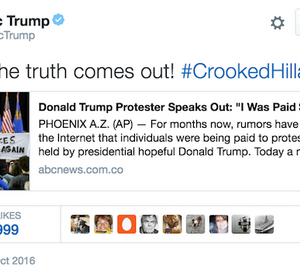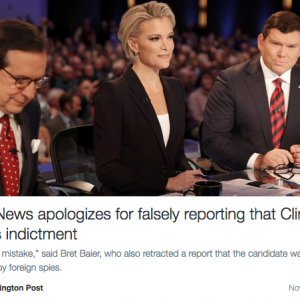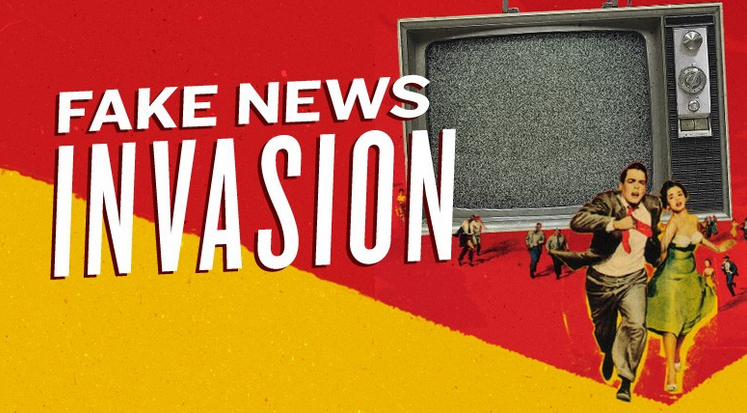This is part one of aNewDomain’s five-part investigation into paramedia and the fake news it purveys. Read the whole series here. -Ed.
aNewDomain  — If you think Donald Trump is the greatest threat facing democracy today, you wouldn’t be alone. But you’d be wrong.
— If you think Donald Trump is the greatest threat facing democracy today, you wouldn’t be alone. But you’d be wrong.
There’s a far bigger threat to democracy and to the freedoms and protections America affords its citizens. That threat is paramedia.
The term paramedia refers to the loosely knit coalition of mostly alt-right media sites and fake news purveyors who constantly pedal a stream of hyper-partisan views, rumors, lies and conspiracy theories as real news by actual journalists. It utilizes high tech tools to accomplish its goal of influencing popular opinion by scamming Trump supporters into sharing such disinformation online again and again.
“I wouldn’t have come aboard, even for Trump, if I hadn’t known they were building this massive Facebook and data engine,” said Steve Bannon, the Trump campaign CEO who runs Breitbart, in a Bloomberg piece this week. “Facebook is what propelled Breitbart to a massive audience. We know its power.”
Paramedia has been in play since the earliest years of the 21st century, as I explained when I first wrote about the phenomenon back in 2005. It has assumed both conservative and liberal leaning forms over the years
But 2016 was the year alt-right controlled paramedia finally managed to overwhelm the traditional press and its traditional base of readers. In so doing, it has propelled an outsider presidential candidate aligned with its racist, utterly confusing agenda toward the White House.
Listen to Mitch Ratcliffe’s 2005 about paramedia on his podcast, Evolution Media, here.
Paramedia DNA
Trump is the main benefactor of the alt-right paramedia’s efforts to influence gullible Americans. By dialing into what they want to hear, it reinforces what they want to believe with startling success.
Worse, the paramedia has provided the Trump campaign with the information it needs to build out a database, target media spending and create outbound email campaigns to amplify fake news and conspiracy theories.
Trump’s direct-mailing reinforces the crisis atmosphere, where outright lies perpetuate the myth of an enemy that supporters need in order to blame some big, bad force for their societal and economic struggles.
So Trump is able to take false claims, like those surrounding rising crime and joblessness, and present himself as a savior, claiming “Only I can save you.”
But what these voters really need protection from are the unscrupulous efforts of the alt-right to use their media naivete in order to advance their own interests. Meanwhile, democracy hangs helplessly in the balance.
Anatomy of a fake news blast
One of the things that makes paramedia so effective is that Trump and his most high profile supporters retweet, reshare and repeat fake news and innuendo to the millions of Trump fans who follow the campaign online. 
Last month, Trump, his son Eric and his campaign manager, Kellyanne Conway, all shared an obviously faked story claiming that Hillary Clinton’s campaign was paying Trump protesters $3,500 a pop. They credited that fake story to ABC News.
But the fake news story in question wasn’t from ABC News, but came via ABCNews.com.co. This would’ve been obvious just by clicking on the link.
Can we believe that none of them did?
Just this week saw Trump repeating a walked back Fox News claim that Hillary Clinton was under criminal indictment.
Also this week, supporters retweeted and shared a bogus story that first ran in TruthFeed and GotNews, which falsely claiming that famed attorney Gloria Allred had paid the former Apprentice contestant Summer Zervos $500,000 to accuse Donald Trump of sexual harassment.
 So how do such obviously fake stories end up getting shared and liked hundreds or even hundreds of thousand of times on the social nets?
So how do such obviously fake stories end up getting shared and liked hundreds or even hundreds of thousand of times on the social nets?
Take a look at one fake story that took off last week, which claimed that US government officials are planning to divert attempts at “rigging” the US presidential election.
The mythology can be traced back to Breitbart, the alt-right site whose chief, Bannon, is on the Trump payroll as campaign’s CEO.
On Oct. 26, it covered a run-of-the-mill Department of Justice statement warning Americans that “election fraud, voter intimidation and discrimination at the polls” on Election Day could violate federal voting laws.
Breitbart covered the DOJ release in an Oct. 26, repeating the facts but also adding that false interpretation that the DOJ had said any attempts to document or report voter fraud — even legitimate ones — were prohibited by law.
“Upon first blush, what may appear to be a middling warning that voter fraud and abuse will not be tolerated by federal law enforcement,” said Breitbart, “also casts a shadow over various lawful election activities with broad language apparently intended to caution individuals from performing their duties.”
Within a few hours of posting, hundreds of Breitbart readers were sharing their outrage about the government’s willingness to let widespread election rigging to continue, unfettered, ostensibly in the interest of making sure Trump could be cheated out of winning.
And within 12 hours, a second alt-right paramedia outlet, the Conservative Daily Post, took that incorrect story to a whole new level.
“Voter fraud is one of the ways that the Democrats plan to cheat in this election,” wrote the Conservative Daily Post a day later. “They have shown that they are willing to cheat since that was how they defeated Bernie Sanders in the primary elections. And now they have the support of President Obama and Loretta Lynch’s Department of Justice.
A press release from the Department of Justice says that people who want to prevent voter fraud might be violating voter intimidation laws,” the post continues. “These people that the department just threatened might be serving as poll watchers just to make sure that there is nothing going on with the votes.”
The Conservative Daily  Post, we should add, is the same “notoriously unreliable site,” according to Snopes, that ran fake news claiming that US Attorney General Loretta Lynch is ordering that “all Confederate flag tattoos must be removed immediately,” that an “illegal alien” worker at McDonalds told cops that the chain “doesn’t serve pigs” and that, should Trump win his bid for the presidency, US Pres. Barack Obama plans to move to Canada.
Post, we should add, is the same “notoriously unreliable site,” according to Snopes, that ran fake news claiming that US Attorney General Loretta Lynch is ordering that “all Confederate flag tattoos must be removed immediately,” that an “illegal alien” worker at McDonalds told cops that the chain “doesn’t serve pigs” and that, should Trump win his bid for the presidency, US Pres. Barack Obama plans to move to Canada.
What swamp are they draining?
Spreading rumors that seem to confirm the fiction that voter fraud is a real problem is just one example of how the alt-right has manufactured an outwardly well-documented version of current events and history that is outlandishly dishonest, hysterically hyperbolic and designed to disrupt public opinion.
Despite there being no evidence that even small voter fraud operations take place frequently only 31 cases of voter fraud have been noted among a billion votes between 2000 and 2014, a network of fake media and hoax sites has managed to create a crisis confrontation between the alt-right and everyone else who lives in the Unites States.
Paging @NeilTurner
And then there’s the bots.
 “The sheer scale of bot activity being perpetrated on behalf of the Trump campaign is completely unprecedented in American politics,” Samuel Woolley, director of research at the Computational Propaganda Project, told Politico earlier this fall.
“The sheer scale of bot activity being perpetrated on behalf of the Trump campaign is completely unprecedented in American politics,” Samuel Woolley, director of research at the Computational Propaganda Project, told Politico earlier this fall.
A pro-Trump bot called @NeilTurner consistently tweets such misinformation to the 30K-plus followers it undoubtedly gathered by often being the first account to respond to Trump’s actual tweets.
Last week it tweeted a faked image of a man being nabbed by immigration officials for trying to vote illegally. It aimed that image to various Spanish-language media, presumably to intimidate Latino voters. The tweet read: I’ve just got word (sic) that an illegal trying to vote has been arrested. ICE is watching voting places closely! Thank you ICE! More to come!
Networks of automated trolls and bots like @NeilTurner are part of an army of disinformation purveyors who’ve been hard at work during the course of Trump’s campaign. They’re a big part of getting slanted stories, rumors and lies into the Trump fan mainstream.
Early Warning
Paramedia is a topic I’ve watched closely for more than a decade. Here’s a posting from my blog, circa 2005, in which I described some of the early examples of paramedia-like influence on the early social web. I was working on social analytics at the time and recorded early influence movements to understand the evolution of online media. There were few organized examples of influence at that time.

This posting also happens to be a podcast I did for Audible, which is still available for download. And the ideas about tracking influence were extremely useful when launching BuzzLogic, a social influence tracking technology. They helped the company raise $12 million, as a historical curiosity.
Turn your mind back to the earliest years of the 21st Century, to Oct. 1, 2005.
Here’s what I wrote, in full:
“Paramedia” describes what happens when peers come together in networks with a purpose. That purpose can be political, economic, social, even personal. That ease of organization is something media consumers, media makers and marketers need to understand and that, for the most part, is such a novel phenomenon that it is simply misunderstood. People think of today’s media as being very like the media of our childhoods, when messages came in big packages and audiences numbered in the millions. That’s a mistake, it leads us to underestimate the power of the small publisher.
 In 1900, there were 2,326 daily newspapers in the United States, approximately one major media outlet per 32,675 people in a country of 76 million. If every newspaper had employed 50 writers in 1900 there were perhaps 115,000 people with access to an audience in the United States. Getting a message out into the world was hard, and since the editors and publishers who controlled the newspaper channel exercised strict control over what got on the page, it was rare to find a writer’s honest opinion in the newspaper. It happened that some journalists made their name on their opinion or even their special insight into the truth, but we remember writers, such as, Upton Sinclair, H.L. Mencken, William Allen White and Lincoln Steffens, because they were unique, not ordinary reporters.
In 1900, there were 2,326 daily newspapers in the United States, approximately one major media outlet per 32,675 people in a country of 76 million. If every newspaper had employed 50 writers in 1900 there were perhaps 115,000 people with access to an audience in the United States. Getting a message out into the world was hard, and since the editors and publishers who controlled the newspaper channel exercised strict control over what got on the page, it was rare to find a writer’s honest opinion in the newspaper. It happened that some journalists made their name on their opinion or even their special insight into the truth, but we remember writers, such as, Upton Sinclair, H.L. Mencken, William Allen White and Lincoln Steffens, because they were unique, not ordinary reporters.
Today, although there are far fewer daily newspapers —about 900 fewer publishing and cuts at major dailies are announced constantly — there are hundreds of national television, regional and local television networks, millions of small publications, in the form of more than 7,000 local weekly newspapers, tens of thousands of magazines and newsletters, Web sites, and blogs. It’s not nearly so hard to get oneself in print and in front of an audience one way or another. Millions of people have access to audiences and millions more expect to be able to talk back to media, to be in conversation with sources of information and ideas, as participants in national and international dialogues.
to get oneself in print and in front of an audience one way or another. Millions of people have access to audiences and millions more expect to be able to talk back to media, to be in conversation with sources of information and ideas, as participants in national and international dialogues.
The odds an idea, a melody or a video clip will find a channel are way up, even though there are more than three times as many Americans competing for attention today than in 1900. T
These are the days when the individual’s opinion is rising, poised to capture the attention of others and, in some cases, starting movements for charity, peace and the greater good—not to mention the usual ration of cruel exercise of raw power.
This is because we live in a peer-to-peer world, where any two computers on the Internet can become a network-within-the-network on an ad hoc basis; it’s no longer necessary to build a distribution network that reaches every corner of a region to keep open a channel to the people there; distribution networks can be assembled on the fly. Technologies for streaming and distributing audio and video files have unleashed micro-audiences for the most obscure and, sometimes, awful programming, but much more, the network is open for all sorts of great content that would go undiscovered in a world where media channels were scarce. Any node on this network can be a broadcast facility, albeit they still have to start small.
 It’s interesting, to me at least, that the evolution of people’s involvement with media is following patterns familiar from the great religious reformations in history. As with the several great spiritual awakenings in American history, there is an assumption that with the birth of ad hoc networking there is an inevitable general housecleaning and purification of the media that must follow. Like those spiritual awakenings, personal experience is favored over and held up as more genuine than the authority of previous institutions.
It’s interesting, to me at least, that the evolution of people’s involvement with media is following patterns familiar from the great religious reformations in history. As with the several great spiritual awakenings in American history, there is an assumption that with the birth of ad hoc networking there is an inevitable general housecleaning and purification of the media that must follow. Like those spiritual awakenings, personal experience is favored over and held up as more genuine than the authority of previous institutions.
Human nature, however, guarantees that we’re going to end up with a less than optimal distribution of resources for telling the story of our lives and times. By embracing the idea of paramedia, we can account for the many complimentary and competitive roles these new contributors to the public discussion play in relation to the existing media, their audiences and the economy.
Paramedia is not one media or one blog, it is many, reorganizing into new networks of influence as the subject of public debate changes. Paramedia can organize to support a product, an idea or a political candidate based on shared interests or values and, because values are seldom aligned for long, political professionals and marketers must be prepared for their coalitions and customer bases to dissolve faster than ever before.
Paramedia remakes itself more like public opinion than the slow-changing media of the past that have tended to reinforce widely held social standards and cultural, political and economic orders. Existing media was like a wrapper, holding ideas in, where paramedia is a seething mass of ideas bursting the limits of distribution that defined the media until the turn of this century.
 The paramedia will play a key role in the evolution of society, filling the massive gaps between the capabilities of the mass media and the intensely individual experience of information we have today, as well as forming the backbone of increasingly permanent political, social and economic relationships between peoples who lived in isolation from one another when media was primarily national in scope.
The paramedia will play a key role in the evolution of society, filling the massive gaps between the capabilities of the mass media and the intensely individual experience of information we have today, as well as forming the backbone of increasingly permanent political, social and economic relationships between peoples who lived in isolation from one another when media was primarily national in scope.
Let’s begin to explore this idea by looking to the origins of the word. As I said, it’s been used by author Todd Gitlin and the Cult of the Dead Cow, but “paramedia” is also the name of a consultancy and has been used enough that it generates 81,800 hits on Google (as of this writing). I’d like to formalize the term here and now, so that we can use it with a common understanding of its meaning and scope.
So, here is my definition of paramedia for your consideration: Paramedia are networks of people with access to media publishing tools and training that align through self-organizing or by explicit planning to promote and support the discussion of an idea, agenda or problem.
The prefix “para-“ comes from Greek, meaning “beside,” and is used in a variety of ways, usually to convey a physical or semantic adjacency between two things. The Oxford English Dictionary describes that which is “para-“ as “distinct from but analogous to” the word it prefaces. So, to “paraphrase” is to repeat a statement, but not exactly. A “paramedic” is not a doctor, but can assist an injured or ill person in lieu of a doctor. The “paranormal” is not the normal, and makes for a lot of bad television about how life isn’t as normal as it seems. A “paramilitary” is not the army, but a group of military-age men and women trained to act a lot like an army.
I’m going to get some flack for drawing a strong comparison between paramedia and paramilitaries, so let me set some qualifications ahead of time. Paramedia may be built through cooperation, they may also be subject to command-and-control by a leadership that has recruited or hired participants to their cause. Functionally, paramedia are most like paramilitary organizations. I don’t, however, want to endorse the idea that paramedia are always acting aggressively or that they are a danger to society like a paramilitary—nor am I suggesting that media must always serve as a kind of battlefield for ideas that precede political action or, even, warfare. The media and especially the paramedia, because they are made up of people, can provide a venue for deliberation, debate and cooperative action.
The paramilitary are organizations of people who are not soldiers but are trained as an ancillary military force. For example, the local police SWAT team, which operates like a special forces unit of the Army, is a paramilitary unit. I’ve heard my local police force described by officers as “paramilitary,” though that’s inaccurate because they are never granted martial authority and, were martial law declared, would have to be deputized by the military before it was able to exercise authority under marial law; they only believe they are paramilitary, because it makes some of the younger officers feel tough.
The paramilitaries we are most familiar with are the extra-national forces that typically operate outside the law, as vigilantes, rebels or extra-governmental strongmen. The flavors of paramilitary are numerous and, whether patriotic or revolutionary, pro-government or factional, paramilitary organizations controlled by your enemies are the rapine murderous jerks you don’t want coming to your home in the middle of the night, whoever you are and wherever you might be living.
Interestingly, in medicine, the prefix “para-“ denotes a disorder, something that is functioning incorrectly. For example, paresthesia is a malfunctioning of the nervous system that makes your skin feel as though it is being pricked with needles.
The three connotations of para- in paramedia are applicable in the new media environment today:
- Paramedia is a form of media that applies the training that have been largely restricted to journalists, artists and storytellers by limited access to the tools and channels for making and distributing messages;
- Paramedia operate beside, between, above and below the traditional practitioners of media and the paramedia channels enjoy an increasingly similar access to audiences through distribution channels.
- Paramedia can be dysfunctional, the assumption by established media is that paramedia is essentially flawed by a lack of professionalism. Paramedia people, likewise, believe the media they intend to obsolete is dysfunctional.
That’s not to say that mainstream media can’t be dysfunctional. It can be incredibly, ostentatiously dysfunctional, as when it turns a presidential campaign into a horse race. Established media, however, have systems of regulation and disclosure built in that the audience can use to measure their confidence in the information they get from a particular media source.
The way paramedia may become dysfunctional is the same as a paramilitary, in that it could be hired or activated by ideology on behalf of a company, a dictator or any other fanaticism. Clearly, I have a mixed opinion of human nature and you can choose to be idealistic about the ability of the whole system of citizens media to police itself, but I see the symptoms of dysfunction and perfection, not just one or the other, in blogs today. Everyone who blogs primarily to grind their own axe today is setting the stage for propagandists tomorrow. Some will migrate to lying for a living—exactly what the mainstream media is accused of regularly today—because there’s no other way to make a living or the pay offered paramedia mercenaries will simply be irresistibly good. There will always be a battle over the truth and power in this dynamic media era.
But, for now, paramedia is new, as surprising to the established media as the guerilla bands that savaged the flanks of Napoleon’s armies as they invaded Portugal through Spain and later drove the French from Spain itself, beginning in 1808. The guerilla war, or “little war,” was conducted by small bands of fighters without much, if any, coordination across the first country to expel one of Napoleon’s armies. In the next 150 years, as warfare became global in scale, guerilla warfare became the successful strategy to pick apart and beat conventional military forces.
It wasn’t until 1935, however, that the word paramilitary was used first to describe increasingly organized guerilla forces around the world. By the 1980s, when Afghan rebels used guerilla tactics to beat the Russian army, paramilitary organizations were responsible for most of the dozens of wars taking place in the world at any given moment. Paramilitary groups had become important players in civil and international wars, as a result they began to assert their power instead of simply acting as the strong arms of others. The Times of London wrote in 1976: “The para-militaries are no longer prepared to be used… unless they have a say in the running of the country.”
The phrase “no longer prepared to be used” is the key to understanding the analogy to the volatile situation in media today. As power shifts from the historical masters of media, the disorganized voices of the paramedia are organizing, and they’ll have their demands. Many bloggers already do. At the same time, the paramedia is fractured and will not likely achieve the monolithic status of the mass media on any issue; there are too many opinions enabled by the easy access to publishing tools for a single idea to go unchallenged by all paramedia publishers.
Here’s what every corporate executive hopes as they look out at the blogosphere, community sites and every other challenger to their exclusive hold on audiences: “If we can find a way to get these people marching with us, it would be great!” So, they design sites that are intended to channel all the good things people might say about them, while filtering out all the negative comments, no matter how constructive or honest those comments may be. They attempt, like an army, to establish a front and keep the fight focused there. Thus, they utterly fail to engage their markets, because the rest of the opinions and ideas the company refuses to acknowledge go elsewhere.
The exemplar of opinion flight is Jeff Jarvis’ dissatisfaction with Dell. Jarvis is a former founding editor of Entertainment Weekly who writes one of the most widely read blogs on the Net. After Jarvis complained on his own blog about the really terrible customer service he experienced when he had problems with a Dell PC, a wave of people agreed with him on his own site and others and Dell, demonstrating no sense of the market, ignored the criticism completely. This armed Jarvis and his fellows with evidence that Dell didn’t get the blogosphere and amplified Jarvis’ initial statements that “the time has come when it’s the seller who must beware. Caveat venditor. For now the customers can talk back where they can be heard.”
I wrote about the caveat venditor idea in March 2003, saying of anyone offering a product or service in the networked marketplace, “Walk the walk, don’t promise something and expect the transaction to go silently into history.” There are trails any potential customer can follow to find out if a vendor is a slimeball or indifferent to customers before they buy. In fact, this was confirmed by a survey, reported by the BBC this week, that 77 percent of consumers who responded to questions said they use blogs to find out what they should buy based on others’ experience with vendors. What companies do for existing customers, good or bad, is now part of the public record.
Statistically, Jarvis and his friends accounted for only a small increase in the number of pages talking about the problems at Dell, yet they got coverage in BusinessWeek and elsewhere. Why? Because the group of bloggers who routinely read and point to Jeff Jarvis’ blog have another and more important agenda in addition to product quality at Dell that catalyzed their actions—they consider themselves the vanguard of the blogging movement, offering services and support to companies that want to work to gain the trust of bloggers. This cause united bloggers who would otherwise not have expressed much interest in Dell product and customer service.
Jarvis posted repeatedly about his dissatisfaction, often citing the progress of his complaints in the blogosphere and offering to travel to Dell to give a presentation on blogs. Likewise, other blog evangelists pointed to Jarvis and Dell as examples of how a company can be brain dead in its response to customers, announcing their approaches to the problem of customer responsiveness through blogging. Seldom have so many consultants found so much to agree on at one time and, besides, Dell looks like a company with a lot of cash to spend on solving its public relations problems.
That wider agenda created a platform on which the critics could gather greater support and marshal wider coverage. The pro-blogging agenda became a vehicle to align a variety of interests and focus them on a goal—this is exactly the way that political coalitions are built and rise temporarily to power; inevitably they dissolve over disagreements. The complaints are no less legitimate because of this, but it is important to recognize that the Dell case shows what happens when small battles are linked to large campaigns: Even giant companies can become casualties if they don’t take the time to measure and react to the paramedia.
It may look like what happened was a series of guerilla attacks, initiated by Jeff Jarvis, but the Dell blow-up was, in fact, an example of paramedia in action. It was coordinated by repetition of the message and the shared philosophy of customer responsiveness among an influential group of bloggers. Jarvis himself posted 20 times about Dell over three months in 2005. That is an act of leadership. Five or ten widely read bloggers started talking about Dell and Jarvis, propelling the issue into headlines and blog postings. This gave others who shared Jarvis’ opinion—either about Dell or how companies should deal with bloggers—ample opportunity to pick up and repeat his message.
To some degree this was an “emergent” event, but it was much more a matter of a leader stepping forward, to the front of a parade just waiting to happen, and blowing the starting whistle. Guerilla media, the one- or two-person crusades we’ve been used to during the print era (think of I.F. Stone’s Washington muckraking or, even, Matt Drudge’s one-man Web spin machine), these diverse small media efforts can now be organized to a significant degree through networks, making any controversy a battlefield of ideas where paramedia can quickly organize and deploy to create the maximum buzz with very little investment.
Not to extend the warfare analogy suggested by the juxtaposition of paramedia and paramilitary too far, just to put a point on it, the tools and channels once available only to a national media company are devolving to the people. At first, as with warfare when weapons like the long gun and land mines were democratized, media makers did what individuals and guerilla bands did, applying media in an ad hoc fashion to address problems, particularly what they perceived to be problems with the established media, political and economic systems. Now we are seeing a new phase of the evolution of media with the appearance of paramedia, groups working in loosely defined and planned ways to open debates on many fronts. For the old media and marketers who are used to addressing a mass market as though it was one demographically idealized consumer, this is profoundly disruptive.
And, as warfare moved from an international stage where national armies met and fought to a transnational warfare defined by paramilitaries like al Qaeda, media is fragmenting public debate itself. Some issues can catch fire because they appeal to different groups, though for entirely different reasons. I’m sure that only a minority of Jeff Jarvis’ readers use Dell computers, but all of them care about how companies respond to criticism posted on a blog. Likewise, a very small audience, but one particularly influential about a high-value topic, can be activated by the right idea at a particular moment in time, as I learned a few years ago when I posted a passing comment on my blog about the Chaordic Commons, a non-profit where I was a member of the board of trustees, and its relationship to the Le Leche League, the breastfeeding movement. Because my comments gave fuel to a dissident group in Le Leche League that objected to the group’s work with chaordic ideas, my posting became one of the most linked to items about chaordic organizations and breastfeeding on the Web for several years—I’m fairly expert in chaordics, but I know very little about or care much about breastfeeding. That blog posting has preserved a blog I have not used in four years as one of the three highest-ranked pages in Google when you search on my name.
The lesson is that all media becomes raw material for paramedia causes.
This dichotomy between what I care about and what I inadvertently got involved in underlines the audience’s and marketers’ challenge when trying to monitor and respond to information in the paramedia. It’s virtually impossible to tell who is really informed and influential about a particular topic when so many people may express opinions in passing. An issue, like President Bush’s military service or John Kerry’s loyalty, can be propelled to the forefront of public debate by a small number of people working together, whether at a large media company or in a loose confederation of bloggers who decide to work to keep that issue in the spotlight. The conservative political movement figured this out long ago, spending billions to create a network of think tanks and opinion makers that can be amplified by networks owned by conservative publishers.
If a catalyzing topic comes along, as it has with Hurricane Katrina and its disproportionate impact on the poor, how it exposes weaknesses in government preparations for disaster and political agendas on the right and left, suddenly many interests align around a single phrase and the entire media environment can light up like a tree in the Amazon full of fireflies that, after starting their abdominal flashing randomly fall into a regular and apparently coordinated pattern of flashing that makes the tree look like it is covered in Christmas lights. But the messages can be almost entirely unrelated, linked only by a common phrase, such as “Hurricane Katrina,” and cover a wide spectrum of issues. The same is true of broad concepts used to align political interests, such as “family values” and “traditional family” can be linked to many conservative issues—the neoconservatives are really good at this stuff already, as I said before.
Go ahead and see for yourself. When you start searching for articles about Hurricane Katrina or find blog postings based on the use of social tagging—the indexing of articles and postings by users who append their own taxonomies to the Web in the form of “tags,” words or phrases that are used to direct searches—the Katrina results can seem to be overwhelmingly diverse because many different topics are associated with the Hurricane. Each thread of the discussion goes off in a distinct direction, having to do with disasters generally, preparation for disasters, this disaster’s impact on blacks or the poor or the New Orleans Police Department or FEMA or former directors of Arabian horse shows. Surely, they can’t all be equally relevant and influential discussions for someone interested in just one aspect of the catastrophe along the Gulf Coast.
Taken separately, most of these postings are many instances of guerilla media. Most of the postings aren’t relevant for most readers. It represents commentary on many fronts, uncoordinated and largely ineffective. The mainstream media is, or was, effective as an opinion setter because its messaging was coordinated.
However, some of the wave of Katrina postings are part of increasingly coordinated campaigns about issues and the direction the nation should go.
What we need to understand is where there are coherent networks forming within the discussion that can propel a particular topic into prominence. Paramedia form when people with common interests or complimentary agendas come into contact and begin to publish with shared goals in mind.
For example, one of the most productive ideas to come out of the Katrina disaster is Jeff Jarvis’ notion of Recovery 2.0, a networked approach to private disaster response and, as a starting point, rebuilding New Orleans. This idea has caught on and many others are blogging about it now, because it appeals to people of all political perspectives, since it is sufficiently vague to sound libertarian, liberal and neoconservative free-market-mongering all at once.
Jarvis has a knack for tossing out big ideas that folks pick up on; he’s a sort of Che Guevara for the paramedia. But even he has a limited range. People don’t count on him for ideas about baseball, sexual performance or child-rearing, so he’d be ignored if he started a campaign in one of those areas. Likewise, someone like Robert Scoble, who is a technology evangelist for Microsoft and almost all things technical, plays booster for so many products that people have come to rely on his blog for access to the latest in technology—even if they don’t agree with him, because Scoble, his attitude or his ideas make a fine foil for blog postings. But they don’t generally go to Scoble for thinking about economics, biotechnology or purchasing linen at a bargain price. (Here’s why Scoble is a successful evangelist for technology generally: He applies the Dale Carnegie “you attract more friends and influence with honey than vinegar” philosophy to everything he writes about, pointing with an almost unnatural cheeriness at any technology, even when he is critical. It engages people, even critics, to address him and not Microsoft itself, which makes his blog an excellent venue for trial balloons and leaks from within Microsoft).
Neither of these bloggers, Jarvis and Scoble, are attractive to everyone all the time. They aren’t even unattractive to everyone at any time, although each has taken more than a few shots at unpopular stands. They are neither universally influential nor uniformly uninfluential. Yet, they both rank in among the top bloggers by traffic and linking on any list of bloggers from the growing number of sources of such lists, and those lists are serving as a palliative for marketers and companies that, faced with a splendidly fractured market, still want to address as few people as possible.
Ranking of sites, the many top-ten, top-100 or top-1000 lists, is a convenient way for a marketer or company to say that, if they address that list, they’ve dealt with the challenges of the conversational market. It’s a fatal mistake, because it’s a strategy that ignores the existence of networks of paramedia and treats all bloggers as though they are competing for the same audience, categorizing blogs instead of acknowledging that it is when networks built on common concerns and shared agendas transcend narrow categories that the real impact of conversational momentum becomes apparent.
Frankly and without too much vanity, because they are just human, bloggers embrace rankism and encourage the idea that their blogs are influential across wide swaths of experience, even when they blog about a limited range of topics. If they can say they are in the top 100 or top one percent overall, they must be influential, the reasoning goes.
Ranking is misleading, because it caters to the idea that new media is simply competing with old media rather than taking up a role long ignored in the market, as well. There are popular bloggers on all topics, but when you look at the specifics of topics about which people publish, individual blogs are seen to be highly specialized. A blog about Microsoft Windows seldom addresses Windows-based smartphones, and there are blogs about smartphones that provide better coverage about Windows-based smartphones even though the site is not about Windows. Likewise, a site about conservative politics will usually focus on a particular topic, like tax policy or national candidates and officeholders, ignoring local issues in which conservatives may also be interested; they go to another site—or many other sites—for that information. In a word, no blog is consistently highly ranked; on some topics, Jeff Jarvis and Robert Scoble are the most read bloggers, on others they aren’t even on the charts.
This media world is incredibly diverse and deeply fragmented. Paramedia—networks of people blogging or podcasting about a related set of topics—provide better overall coverage but less detailed data than specialized sites and can leverage shared interests to deepen the impact of messages. Paramedia comes into existence only when messages begin to be repeated, when people begin reinforcing the statements made by others consistently and they reach people who care about the topic regularly.
It’s when the specialized sites begin to cooperate or even collaborate to spread messages that, as participants in the media, we have to tread carefully. We need to know why and when ideas are being propagated, if there are trade-offs or compromises on the truth. Just as we need to know who backs a television network or pays for a documentary that attacks a political candidate, we need to examine the motivations of paramedia in order to judge how to take the information and ideas they spread.
Remember, though, that it is very early in the paramedia era. Influence today seems to be highly concentrated in popular blogs because so few people blog today—only about 10 million, by the most optimistic estimates (fewer than the number of blogs, because so many bloggers operate multiple blogs. Eventually, a lot more people will be talking publicly about their pet political issues or what they do for a living, how they do it, how they think the world should be run. Today’s blogosphere, while wonderful in its diversity, is just a proverbial seed for an emerging global conversation and tracking the evolution of paramedia will be an important skill for politicians, marketers, and citizens.
Unlike in traditional media or the World Wide Web, where the first mover dominated future development of the market, individual bloggers with high rankings according to Technorati, BlogPulse or PubSub, the main tracking services for blogs, will not be in charge—unless they have strong networks supporting the ideas they propagate and driving traffic to their sites consistently, because they stay relevant to those networks. Paramedia is borne of networks of influence, not simple traffic and link counts. Lasting influence will depend upon how effectively sites keep their interests aligned over time.
Those networks are heavily dependent on the context in which they exist. Listen, paramedia are creatures of their subject matter and membership; comparing different paramedia is like comparing paramilitary organizations by imagining how one would fare when fighting another. Paramilitary exist in a particular place and time, taking them out of that context destroys the paramilitary motive, so it’s impossible to say that Castro’s Cuban revolutionaries could take al Qaeda in a head-to-head fight or that UNITA, the Angolan revolutionary front, could beat the paramilitaries of the cocaine cartels. When the people who make up those networks lose their motivation, they evaporate. The only constant in warfare today, besides nationalist, religious or racial motivations, is money, which can buy a paramilitary organization and drives concepts of national interest, such as the United States’ desire to secure access to oil and economic growth.
Since money is such a powerful motivator, we need to be especially diligent in the face of new paramedia efforts to convince us to believe, buy, vote or march behind a particular leader.
We need greater transparency in paramedia networks, as well. Seeing who is working together, where common sources of funding might be on the move to support the appearance that there is wide agreement about a topic, and knowing who is talking will be keys to critical participation in the media conversation. In the past, newspapers have published anonymous letters that make allegations or offer insults—anonymity in paramedia will be a negative, for the most part, because it shelters the publisher from the responsibilities that come with access to the audience. I hope we can agree that participation in the media conversation is usually a public act, one more like talking on the street with other people than whispering rumors in back alleys. The newspaper that published an anonymous letter accepted the responsibility in that the publisher was sitting behind a desk and could be found by an injured party demanding equal space and time to respond, or to sue for libel. A large measure of that public role has to pass to the paramedia publisher, so that publishing continues to be recognized as a public act rather than a private one.
If out of all this conversation today agendas can be woven and coalitions assembled, we have to be very aware of the power of paramedia to shape the direction of the global conversation. Not only can individuals band together to launch political campaigns to fill potholes or call for peace in Iraq, but companies and non-profits can assemble apparently diverse voices to support their agendas, as well. So, just as there are many paramilitaries acting on behalf of governments, rebels, drug cartels and companies around the world, we need to be aware that paramedia is a mixed bag that must be carefully monitored in order to avoid failing victim to coordinated efforts to mislead, misinform and obfuscate.
Gad, you’d think I don’t trust anyone or anything I read. Well, generally, I don’t. I’m the kind of skeptic that, according to author Michael Shermer, by examining ideas carefully weeds out bad ideas to make room for good ideas to flourish. Paramedia represents both a great opportunity and a extraordinary threat to our intellectual freedom, just as democracy opened the door to modern warfare and totalitarianism to come into history with it. We have to make the best of what we have, instead of assuming we’ll get the best if we just have faith.
With that commitment, we can make the best of paramedia, something much greater than the media epochs that preceded it. Paramedia is a remarkable tool for political, social, economic and personal change. Let’s approach it critically and constructively, so that when the world is changed the greatest number of people can be happy with the results.
The Bottom Line
The alt-right and the fake news media that so successfully support it aim to destroy our democracy as completely as it can, calling it “draining the swamp” of corruption in Washington.
There are other paramedia at work today, as well, across the political spectrum, but the alt-right has taken it further, and into dangerous territory where free nations can fall into authoritarian tyranny.
Democracies generally degrade into tyrannies, as Plato famously said.
That’s a good old saw to remember when thinking through the implications of paramedia. We need a free press, but that freedom comes at a price.
We must remain diligent in defense of our freedom by tackling lies forcefully, so that they do not take hold. A people’s decisions can only be as sound as the information they have when making those decisions.
Along with democracy, truth, the scientific method, and tolerance are at stake here.
For aNewDomain, I’m Mitch Ratcliffe.
Cover image: The Detroit Free Press, All Rights Reserved.
Gina Smith contributed to this story.
This article is part of five-part investigative news series that digs into the paramedia fake news problem. Read the whole series here.













